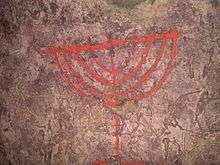Jewish catacombs of Venosa
The Jewish Catacombs of Venosa are a set of catacombs located near the Italian city of Venosa, Province of Potenza, on Maddelena Hill. The exact date of construction for the catacombs is unknown, but it seems likely that they were built and used between the 4th and 6th centuries C.E., and their existence has been known since the 19th century. The structure of the catacombs is simple, with two parallel tunnels connected by passages.[1]

Most of the names listed in the catacombs reflect the tendency of Jewish diaspora to take Greek or Latin names as opposed to names in Hebrew, with only a small minority of the people buried there having names reflecting a Hebrew etymology. The earliest writing in the catacombs is usually in Koine Greek, with Latin existing in the newer and deeper sections of the catacombs.[2] There is more Hebrew text in these catacombs than in the better known Jewish catacombs of Rome. Religious iconography, such as the menorah, can be seen in the catacombs.
References
- Ḥa̱klîlî, Rāḥēl (1 January 1998). Ancient Jewish Art and Archaeology in the Diaspora. BRILL. p. 273. ISBN 90-04-10878-5.
- Davies, William David; Finkelstein, Louis; Katz, Steven T. (1984). The Cambridge History of Judaism: Volume 4, The Late Roman-Rabbinic Period. Cambridge University Press. pp. 499–502. ISBN 978-0-521-77248-8.
External links
| Wikimedia Commons has media related to Jewish catacombs of Venosa. |